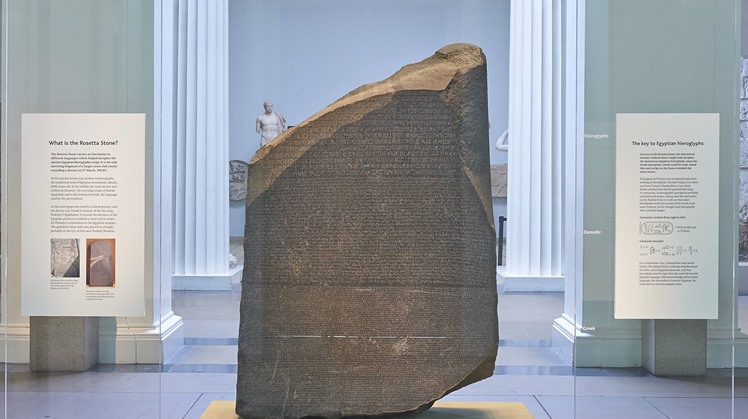Today passes the anniversary of the opening of the Louvre Museum in the French capital, Paris, on this day, August 10, 1793 AD, that is, a year after the French Revolution stormed it, which was known before that as the Tuis-les-Rey Palace, where it was the residence of the kings of France before the French Revolution. Which includes Egyptian artifacts that were illegally seized, such as the Rosetta Stone, for example. The Rosetta Stone is not the only piece stolen from Egypt, but there are thousands of pieces, and we review some of them through the next lines.
Rosetta Stone
The Rosetta Stone is in the British Museum, which was seized by the French colonialism by force and unlawfully and placed as a gift in the British Museum, illegally, since British forces defeated the French in Egypt in 1801, and the original stone became in possession of the British after the surrender of the French campaign and transferred to London, it has been publicly displayed in the British Museum almost continuously since 1802, and has been the most visited monument in the British Museum.
The Rosetta Stone is made of basalt, its height is 113 centimeters, its width is 75 centimeters, and its thickness is 27.5. The stone is engraved with inscriptions in three ancient languages, namely hieroglyphics, Demotic or Coptic, and Greek. The inscriptions were inscribed on this stone during the reign of King Ptolemy V.
The stone represents a letter of thanks and gratitude addressed to a group of priests from the city of Memphis to King Ptolemy V for exempting the temples from paying some fees. It was written in 196 BC.
The hieroglyphic language was used because the priests at that time still used it, and the common people were using the Demotic language, so the writing was done on the stone in three languages so that the king and the common people could read it.
Statue of Ankh-Ha-af
Statue of "Ankh-Hafe", one of the sons of King Sneferu, founder of the Fourth Dynasty, who was a minister to King Khafre and was responsible for all his works related to architecture. He was known as the engineer who supervised the construction of the pyramids of Khufu and Khafre. ,48 cm, which is carved from limestone and then colored, and is currently displayed in the Boston Museum of Art in the United States of America.
Statue of Ankh-Ha-af
Statue of Ankh-Ha-af
Nefertiti
The head of Nefertiti came out by fraud and deception, by deceiving the German archaeologist Ludwig Borchart, the discoverer of the piece, on December 6, 1912 AD, in Amarna.
On January 20, 1913, a meeting was held between Ludwig Borchart and the Director of the Antiquities Inspection of Middle Egypt Gustav Lefevre to discuss the division of archaeological discoveries that were found in 1912 AD, between Germany and Egypt, where the division of discoveries was according to the antiquities law at the time “equal shares” between Egypt and the excavation mission Through a joint committee chaired by the representative of the Antiquities Authority from the Egyptian government.
At the time of the division, Borchart, director of the Inspection of Middle Egyptian Antiquities, Gustave Lefevre, said that the statue was made of gypsum, but it was made of good limestone, and Egyptian law prohibited the exit of any piece made of limestone.
After Lefevre signed the division, this was approved by the director of the Antiquities Department at the time, Gaston Maspero, and then shipped directly to Berlin. Borchart's excavations at Tell el-Amarna, and other artifacts found in the el-Amarna excavations to the Berlin Museum.
The zodiac plate or planetarium was stolen from the ceiling of the temple of Dendera and transported to Paris.
 Thu, Aug. 11, 2022
Thu, Aug. 11, 2022